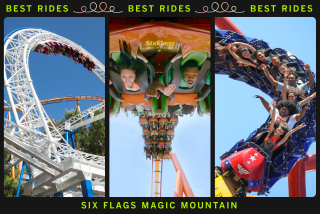TV Reviews : ‘Big Top’: A Nostalgic Look at the Circus Era
- Share via
One Saturday in 1942, I watched a traveling circus come to Los Angeles, unload its animal cages and unfurl its huge, flapping canvas tent on a vacant lot near 9th and Figueroa.
The excitement wasn’t the show itself so much as a child’s exhilaration at the smell of the sawdust and the sweat of the razorbacks--as circus workmen were called--rolling out this big top and lifting it to the sky.
In truth, the golden age of the circus was long gone, but this bedizened vestige of the great old traveling circus that roared into a town for a day and then packed up in the dead of night and headed for the next town left a lifelong thrill. No wonder wanting to run away and join the circus became as American as Huck Finn.
That sense of innocence and wonder is richly documented in the nostalgic “Barnum’s Big Top” on “The American Experience” tonight (at 9 p.m. on KCET Channel 28 and KPBS Channel 15, at 8 p.m. on KVCR Channel 24).
Using rare archival footage, home movies, posters and newspaper ads, producer Matthew Collins dramatizes the history of the circus from its dirty horse-drawn bohemian days in the mid-1800s to its jumbo Barnum & Bailey three-ring phantasmagoria at the turn of the century.
We see an 1898 film (two years after the invention of the motion picture) of a Barnum & Bailey circus parade sweeping into a small town. Schools and businesses shut down to watch the caravan of bizarre beasts (camels and elephants) and exotic men and women (the sideshow freaks like the Fat Lady, whom Barnum paid by the pound, the Siamese twins and the Fiji Mermaid--which was, we’re shown, the carcass of a monkey sewn to the tail of a fish).
Here show-biz hokum flowered, circus sharpies suckered the village “rubes,” and Barnum himself cultivated the name “Prince of Humbug.” Americans loved it. For many, the arrival of the circus was the only day of the year they had any fun.
“Barnum transformed the hard-time dullness of our streets into the gayest of holiday airs,” reports an Ohio newspaper, circa 1875.
We catch the giddiness of performers walking on wire or flying through the air in the early 1900s, when more than 100 circuses, giant organizational wonders, traversed the country by rail--before cars, movies and the modern zoo made the old-fashioned circus passe.
Finally, you sense the lingering whiff of the dusty circus in our entertainment today--from the “Pig Eats Baby” supermarket tabloid headline to the dazzling, not-your-garden-variety Cirque Du Soliel.
More to Read
The complete guide to home viewing
Get Screen Gab for everything about the TV shows and streaming movies everyone’s talking about.
You may occasionally receive promotional content from the Los Angeles Times.






